Here you’ll find offensive basketball plays utilizing the 1-3-1 formation. Just follow the key to understand the diagrams and follow along with the text descriptions. Practice, practice, practice until you can run these plays in your sleep. Only after hours and hours of perfect practice will you be ready to DOMINATE!
Key
1 = Point Guard
2 = Wing
3 = Wing
4 = Post
5 = Post
Red Dotted Arrow = a pass
Black Straight Arrow = player movement
Each offensive basketball play is separated by a horizontal line running across the page.
Offensive Basketball Play #1
1-3-1 Formation: Offense 1-3-1
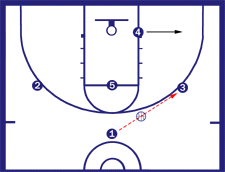
4 runs to corner as 1 passes to 3
(you want to keep your wings wide to help open up up the initial inside passing lanes)
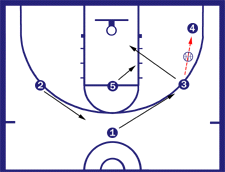
3 will pass to 4, make cut straight to the basket and is first option for 4’s pass. 4 will make the pass to 3 (if open) and 3 will attempt lay-up.
If 3 is covered, 4 will attempt pass to 5 (who has moved in behind 3)
1 and 2 rotate to strong side
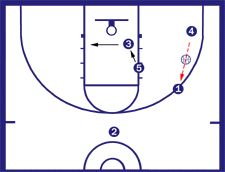
Situation – 4 has no passing options to 3 or 5. 4 now passes to 1 to start weakside rotation.
5 takes low post position while 3 cuts through lane towards weakside wing position.
2 is positioned at top of key as pass option for 1.
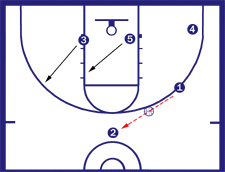
3 finishes path to wing position and 5 rotates to high post as 1 passes ball to 2.
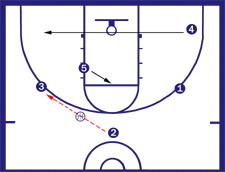
1st option – 2 passes to 3 for jump shot.
If 3’s jumper covered, 4 has run baseline to look for pass while 5 is positioned at foul line as another option.
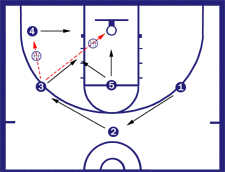
If there, 3 takes jump shot while 4 & 5 run to hoop for rebound.
No shot – 3 passes to 4 and cuts to basket.
If ball passed, 5 falls in behind 3’s cut. 1 & 2 rotate to strong side. If ball is rebounded without a sure shot, kick it out & start play again.
Offensive Basketball Play #2
1-3-1 Formation: Easy
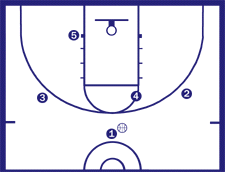
Begin in 1-3-1 position
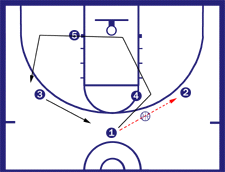
1 passes to 2, then cuts to basket while 4 provides a screen.
If 2 has no pass option to 1, 1 then moves out to weakside wing position.
Meanwhile, 3 has replaced 1 at top of key.
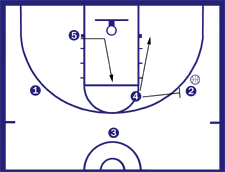
5 makes cut to hoop, then takes a high post position.
4 moves from high post to low post position.
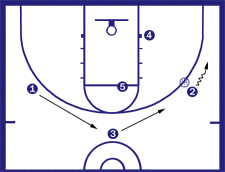
Offensive Basketball Play #3
1-3-1 Formation: Multi-Purpose 32
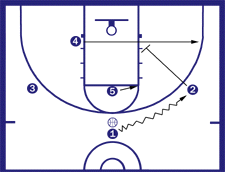
1 dribbles to wing position
4 cuts to corner behind 2’s screen through low post.
5 moves to strongside elbow.
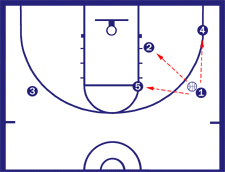
Options for 1 – Pass to 4 for jumper, pass to 2 under the basket, pass to 5 at high post.
3 stays at weakside for possible rebound.
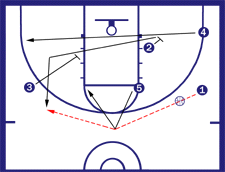
Situation – Everything’s covered…
5 moves to top of key for 1’s pass.
2 sets screen for 4 (who cuts to opposite corner), then slides out to wing position & receives pass from 5.
3 sets screens for 2 & 4, 5 moves to strongside elbow – 1 available for possible weakside rebound.
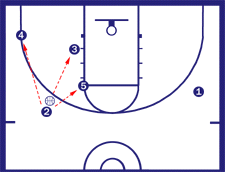
Options for 2 – Pass to 4 for jumper, pass to 3 under the basket, pass to 5 at high post.
1 stays at weakside for possible rebound.
(notice this is same as 2 diagrams ago but on opposite side)
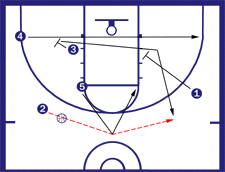
Situation – Everything’s covered…
5 moves to top of key for 2’s pass.
3 sets screen for 4 (who cuts to opposite corner), then slides out to wing position & receives pass from 5.
1 sets screens for 3 & 4, 5 moves to strongside elbow – 2 available for possible weakside rebound.
Note that this last diagram puts you back into the same formation as diagram #2 of this play (except that players 1, 2 and 3 are in different positions). Basically, if you have players who can shoot well from the outside but a weak center, this offensive basketball play can be effective.
Also, you’ll notice that players 1, 2 and 3 interchange their positions as the play evolves. Be sure these 3 players are adept at passing and setting screens. Your center should be able to shoot well as he or she will be handling the ball in the low post often.
Offensive Basketball Play #4
1-3-1 Formation: Baseline 3
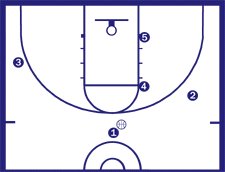
Note how wing 3 is positioned closer to the corner upon set-up. We’re hoping the defense may think 3 is setting up for a 3-point shot.
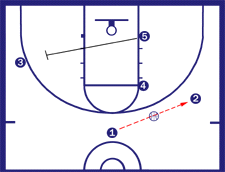
1 passes ball to 2.
4 remains positioned at strongside elbow and awaits pass from 2.
5 cuts through baseline to set up a screen for 3.
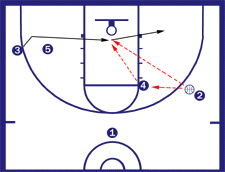
3 cuts to hoop around 5’s screen. 4 gets pass and quickly makes “back-door” pass to 3.
2 has option to pass right to 3, then move in for rebound or dish back from 3.
If 4 can’t make “back-door” pass to 3, 1 may be open for 3-point shot.
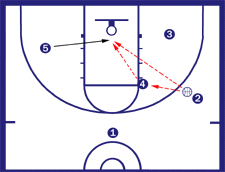
If last diagram failed because 3 was covered, 5 can cut to basket, receive pass from 2 or 4 and take close range shot.
